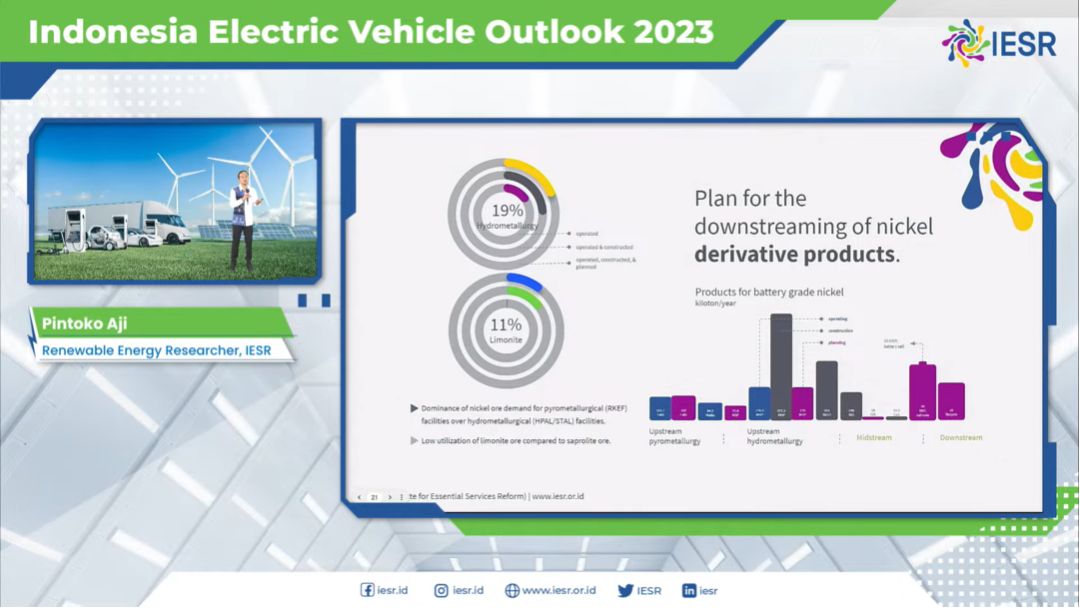Over the present decade, the popularity of electric vehicles (EVs) has witnessed a significant increase with year-over-year sales showing exponential growth. According to reports from Bloomberg New Energy Finance (BNEF), there are already almost 20 million EVs on the road until the end of 2021. To enhance energy efficiency, ensure tailpipe emission reduction, and decrease reliance on oil fuels, EVs have become an attractive choice for both stakeholders and the general public. Taking into account the prevailing trend and several additional benefits, Indonesia, being the largest nickel reserves country, through President Regulation 55/2019 regarding the BEV acceleration program, has taken proactive measures to participate in the global EV industry, particularly in the battery sector. Following this regulation, the Ministry of Industry was established outlining the industry roadmap and local content requirements (LCR) through Ministerial Regulation 20/2020.
As of 2023, the weighting of the Local Content Requirement (LCR) in the Indonesian electric vehicle (EV) industry has adjusted. The assessment of the assembly process, previously at 20%, has been reduced to 12%, with the remaining 8% being reallocated to the calculation of the main components, including the battery (35%), electric motor (12%), and chassis (11%). The importance of LCR in Indonesia is relevant in the context of supplying for government procurement or projects. In support of the growth of the domestic EV industry and attracting investment, the Indonesian government has implemented various initiatives, including the President Instruction 7/2022 for public procurement and subsidies plan for the purchase of LCR-compliant electric vehicles.
The weight of batteries in electric vehicle (EV) industries highlights the importance of utilizing domestically produced batteries for improving the overall LCR. The current state of the battery industry, however, poses challenges for mass production. The Institute for Essential Services Reform (IESR) team sought to understand the gap in technological capabilities within the domestic battery industry. To achieve this objective, the team conducted exclusive interviews across the upstream, midstream, and downstream sectors of the industry. The purpose of these interviews was to evaluate the industry’s preparedness in meeting both government targets and the demands of the EV market. The comprehensive assessment aimed to gain a thorough understanding of the domestic battery industry.
Battery EV production flow
Upstream sector industries
The upstream sector in Indonesia’s EV industry is rapidly growing, ready to meet market demands. The government has reinforced this growth with MEMR Regulation 11/2019, which governs mineral and coal mining and bans nickel ore exports. Despite the controversy, the regulation has led to the construction of two HPAL nickel refineries and 5 more are in the works. According to the Indonesia Nickel Miners Association, there is yearly demand for 50.57 million tons of saprolite and 1.2 million tons of limonite ore for the HPAL plants, expected to produce nearly 1 million MHP/MSP and 316,000 tons of derivative products including 140,000 tons of Cr concentrate, 136,000 tons of Nickel Sulfate, and 19.5 tons of Cobalt Sulfate. One developer has even introduced its refining technology, the Step Temperature Acid Leaching (STAL) process, designed to refine limonite ore with a nickel content of less than 1.6%, yielding MHP as the final product at its prototype plant.
Midstream sector industries
The lithium-based battery sector has seen slow growth due to high investment needs and limited experience. Aside from three major investment plans for battery production (IBC-LG, IBC-CBL, and Indika-Foxconn) that are underway, IESR has gathered information on existing and growing companies. These companies have production capacity for battery cells, ranging from 30 to 1 thousand cells per day. An interesting development is a start-up from Universitas Sebelas Maret that has a partnership with another start-up from the same university for active material and precursor production.
To align with NCM or NCA nickel-based cathodes, the upstream sector’s battery precursor production process needs to be continued domestically. However, local battery companies use LFP for their business due to safety and long life-cycle considerations, even though it has lower energy density compared to nickel-based options. As a result, class 1 nickel production in Indonesia’s upstream sector is not yet sufficient to meet the needs of the cathode or battery cell industry within the country.
Downstream sector
As one of the world’s largest producers of motorcycles, Indonesia has no major obstacles in assembling EVs. The frame or chassis is the most established component to be produced domestically. Meanwhile, some companies have produced electric motors (powertrains) and supplied E2W production for state-owned enterprises.
However, the recycling or reuse of battery cell waste for second-life batteries is yet to be fully developed. But, researchers at Universitas Gadjah Mada have taken the initiative by starting the development at a laboratory scale. Despite limited EV usage in the country, this sector is expected to be promising due to its potential to extract rare materials like lithium and easy access to metals required for battery production.

